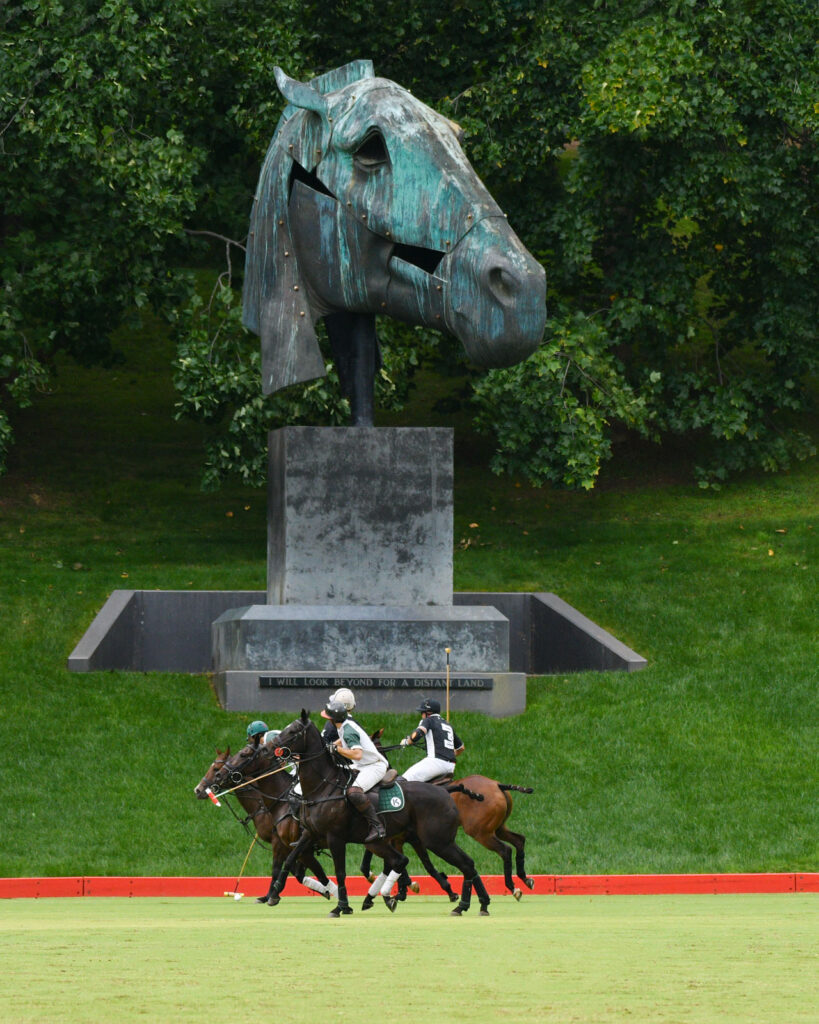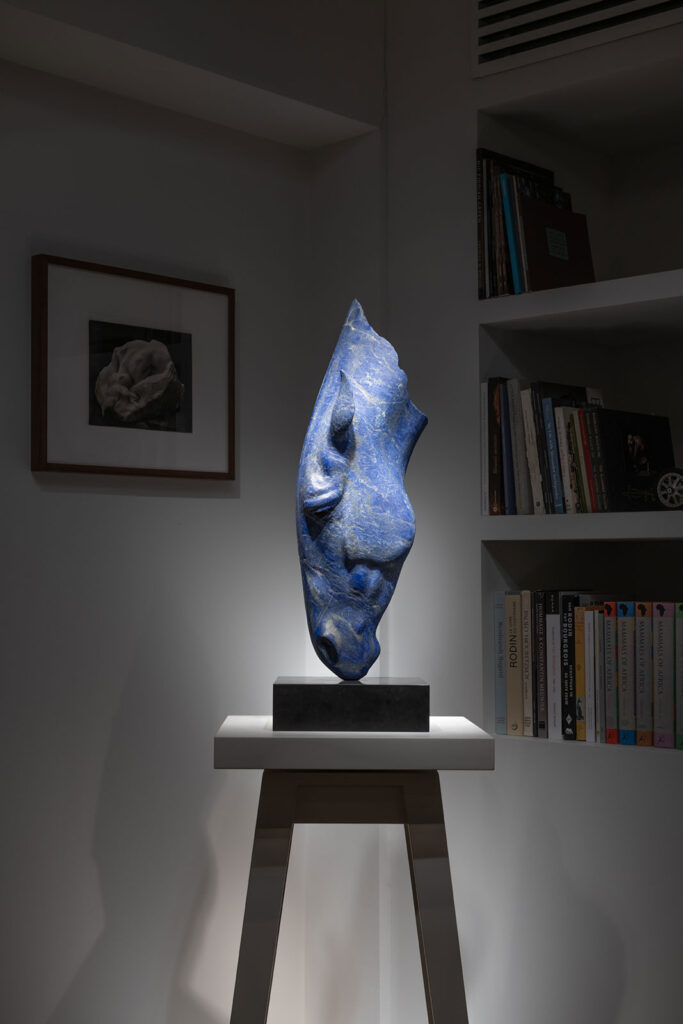An Interview by Jill Novotny
Click to view the gallery in the full-screen digital issue:

Your work feels deeply traditional yet very modern. Can you speak of your inspirations and influences, as well as how you see yourself breaking away from them?
In 1983, when I was studying at Chelsea College of Art, I was sent to the British Museum on a transcription project, with the brief to go and draw something that inspired me. When I was there, I came across the Elgin Marbles/Parthenon Frieze, and they greatly impacted me, in particular, the Horse of Selene. These Greek principles of perfection, harmony, proportion, balance, and seamless craftsmanship have stayed with me ever since. It is this which I think most makes my work classical and traditional, combined with the use of traditional practices such as hand-carving, hand-modeling, and working in bronze. My work has often been regarded as modern through the daring use of scale, which has become a well-known characteristic of my practice—everything I found in one encounter with a single head of a horse carved in marble.
A few of the influences that affect me most significantly include the English countryside, Beethoven, Donatello’s David, architecture and its balance, proportion, and harmony, my father’s use of a silver pencil, and the annual making of marmalade.


What first drew you to sculpt horses over other subjects?
There is only one animal—the horse embodies and carries everything I am not. Representations of the equine form can be visible in some of the oldest surviving examples of Western Art, notably the Chauvet and Lascaux caves in Southern France. Emphasis on this animal, from prehistoric creativity—the Lascaux caves contain 364 drawings and pigment paintings of horses thought to be 17,000 years old—has albeit declined alongside their removal from our daily lives as vehicles for transport, tools for labor, and warfare. The physical decline of the horse within 20th-and 21st-century life suggests that their consistent presence in my work is of more metaphorical value. The horse embodies values of grace, strength, acceptance, beauty, serenity, nobility, loyalty, silence, connection, and suppliance, which are all so powerful to us.
Your work is famously displayed in public spaces, but it is also found in many private collections across the world. Do you feel differently about work that is public or private, and does it affect your creative process?
I feel my work is a way in which I have tried to turn the invisible into the visible, be it just a feeling or a human principle. It is a story of my journey, and as I walk, I desire to speak and tell that story through the head of a horse. Perhaps my initial intention way back at the start was to make something “sing a beautiful song,” and maybe, through the various mediums I have turned my hand to, I have tried to create something that might be felt and even responded to, following a chance encounter by a passerby. My goal when creating work for public spaces is to create something open, honest, and inclusive to share my story and meet the world. Fundamentally, public work offers an opportunity for connection.
Based on the Duke of Wellington’s warhorse, Nic’s 12-foot sculp- ture Copenhagen (now situated at Wellington College and Ascot Racecourse) is a tale of beautiful conflict. When seen facing the left, the piece is kinetic, dynamic, and reflective. By contrast, when seen facing the right, he is consumed by angst, with near-violent modeling that leaves the nose twisted towards you.
A balance of War and Peace, the emotive testament of the mighty head evolves as you walk around it. The clay medium of its creation has been highly central in achieving the energy of this testament and the stark contrasts it possesses. The cast at Ascot Racecourse is another example of how these monuments may sing to their respective landscapes despite not being specifically commissioned for this location. Although Ascot has a highly historical relationship with horses, the poised energy of Copenhagen works to perfectly complement the range of excitement and anticipation one may feel at any racecourse. The sculpture in the pre-parade ring foreshadows, (in Copenhagen’s case) War and Peace, (in Ascot’s case) triumph and frustration.
This sculpture was purchased in 2018 by the Ascot Racing Authority as a gift to Prince Charles to mark his 70th birthday.
In what ways do you work with materials to achieve different colors? What do the different materials lend to your work?
The different materials I have worked with, all ripped and pulled out of the earth’s crust, give me matter to wrestle with, emotionally and physically. The different limitations or possibilities of each allow me the chance to approach each piece uniquely, from clay to Burmese jade, lead to marble, plaster to gold, and on and on: alabaster, copper, wax, silver, lapis, malachite, and on, always curious.
Each material teaches me how to listen and respect, and then to respond to each. My overriding desire is to learn. I am always searching, and always with the knowledge that I will never arrive or find that place of perfection, and yet, along the way, I excitedly find and make some work that brings me closer towards it. I enjoy learning how little I know and the great unexpected moments when something is revealed from the core of each material.
Working in bronze is a fabulous medium as it is age-old and practically everlasting. I then patinate my bronzes differently, allowing me to achieve a variety of colors. I mostly like to work with verdigris (green) to give an aged, natural effect or brown hues which I think link to more classical symbols of strength. Bronze is also extremely powerful on large-scale works, safe to install in water, and very strong against the elements.
I have been working since lockdown with a number of semi-precious stones to make smaller carvings by hand. I recently completed a 24-inch-tall carving from solid Lapis Lazuli sourced from Afghanistan. The color of these stones is sensational, from the vibrancy in lapis and malachite to soft pastels in jade, rose quartz, chrysoprase, etc.
Finally, I have made a number of large-scale Carrara marble carvings over the past few years, ranging from 7 feet to 14 feet high. I work on these in Pietrasanta, Italy, near the Carrara quarries. The studio I work at is the last to carve works of this scale by hand, without the use of robots or machinery. It is a beautiful process.
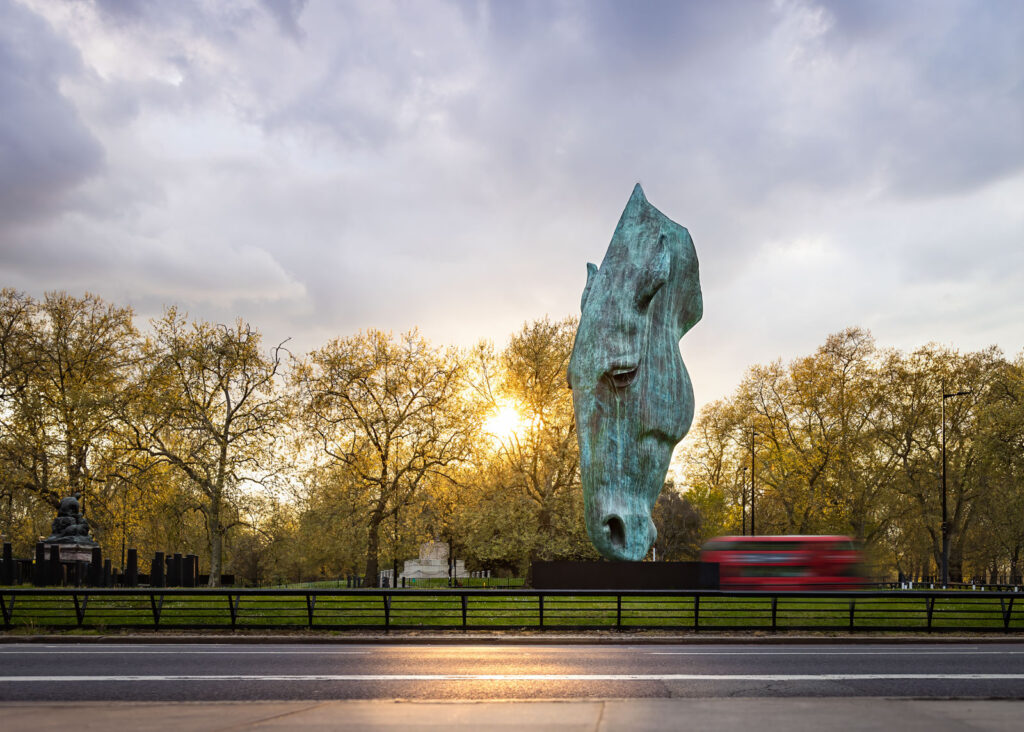
Still Water, 33-foot bronze, 2010, at ParkLane, London,U.K.
Nic’s most famous work to date is his 33-foot-tall Still Water bronze in Central London. In its freestanding nobility, the piece offers itself for the public to witness from any angle. The low base is often sat on or leant on by members of the public in the summertime, allowing engagement in both an intimate and candid way.
Since its installation at Marble Arch in 2010, it has had an impact on daily commuters, rendering its presence today freely obvious and indispensable. The charming relevance of having a sculpture by a British artist situated at the heart of the capital is enhanced by the flurry of red buses, along side the Household Cavalry who ride down from Hyde ParkBarracks every morning, whatever the season. The reality of Still Water depicts a horse drinking, an action only carried out when the animal is completely calm, safe, and in control. With this understanding,the universal appeal of such tranquility renders this monument inspiring and impactful.
When beginning a new project, how do you decide on the scale?
Scale finds me; I have no real plans. I wait and am often guided by an unknown hand that prods me into each process of making and working. One leads to another and on to the next, and sometimes it goes to a monumental scale, and sometimes it fits in the palm of my hand.
Can you describe a bit about your process?
The process is something like this: from awakening at dawn to the end of the day. When I am inspired or driven, I cannot wait to get up in the morning, and I will travel through the work until that work is complete. I am impatient, for I am aware that there is only so much time, and I have to work to live, or as the English do at times, I live to work, and yet I am just searching for that perfection which I know I will never find, and yet my joy is in the journey, for the journey gives me purpose.
Note: Nic usually begins modeling with clay and plaster, and then once pleased with this initial piece, he has it scaled up, if the intended work is larger than 6 feet. Once he gets the scaled- up version, he then reworks the whole surface, adding more clay or plaster as he sees fit. Once completed, the work will go to the foundry to be cast in bronze before Nic patinates it. He also works in hammered lead and copper sheet, joining the sheets together with rivets over a fiberglass form.
Do you begin with a complete design in mind, or do projects evolve as you work?
The work drives me on and leaves me—I know little at the beginning of a piece of work, yet as I go down the road, it is revealed to me where and how to make and forge and change the shape and form of that piece to make it stand up and balance and maybe “sing” in its heart.
What do you consider your greatest accomplishment, and what goals do you aspire to/future projects do you have in mind?
My greatest work so far is perhaps the 14-foot marble of How Still the Night. It is, for me, coming close to that place where it is balanced in all its parts—beautifully executed and beautifully engineered, meticulously complete and finished—for me, I am very proud.
Whilst I have already sold a number of monumental sculptures to clients in America, my most important future project is an American touring exhibition in conjunction with The Sladmore Gallery, London, who have been my agents for the last twenty-five years. This will begin in Wellington, Florida, in February 2024.
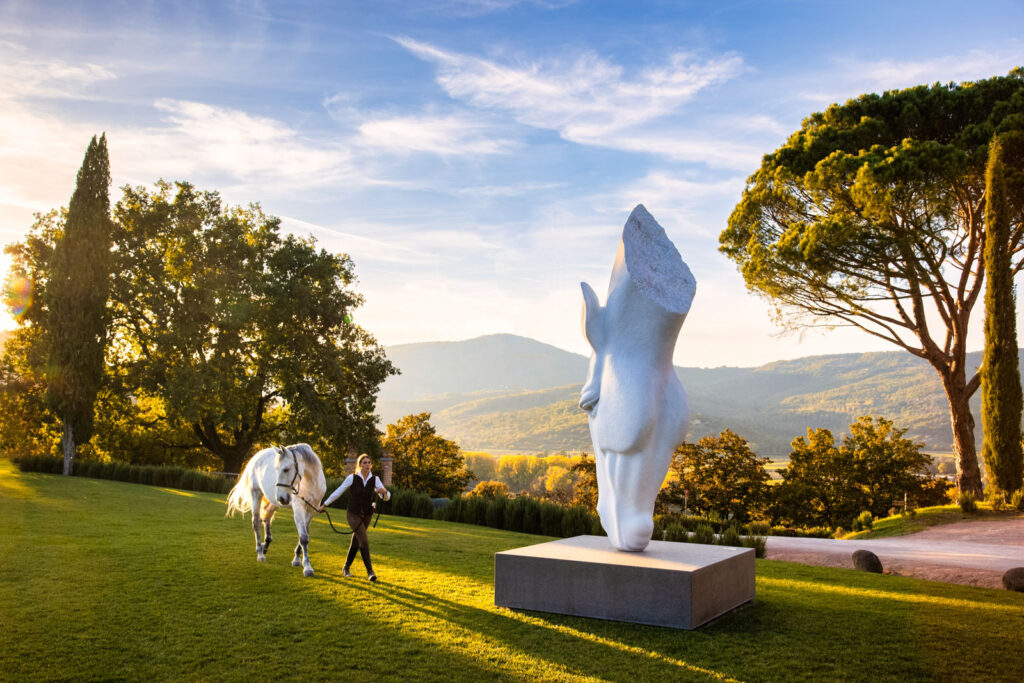
How Still the Night, 14-foot hand-carved CarraraMarble, 2022,at Reschio Estate,Italy.
The future—one day, to rest and know that I am just a messenger of a story that was written long ago,and I have used my hands to express something that I don’t even know exists, and I hope that some may stop and just smile in their hearts.” ~Nic Fiddian Green
For further information, please email nfg@sladmore.com or visit www.nicfiddiangreen.com.
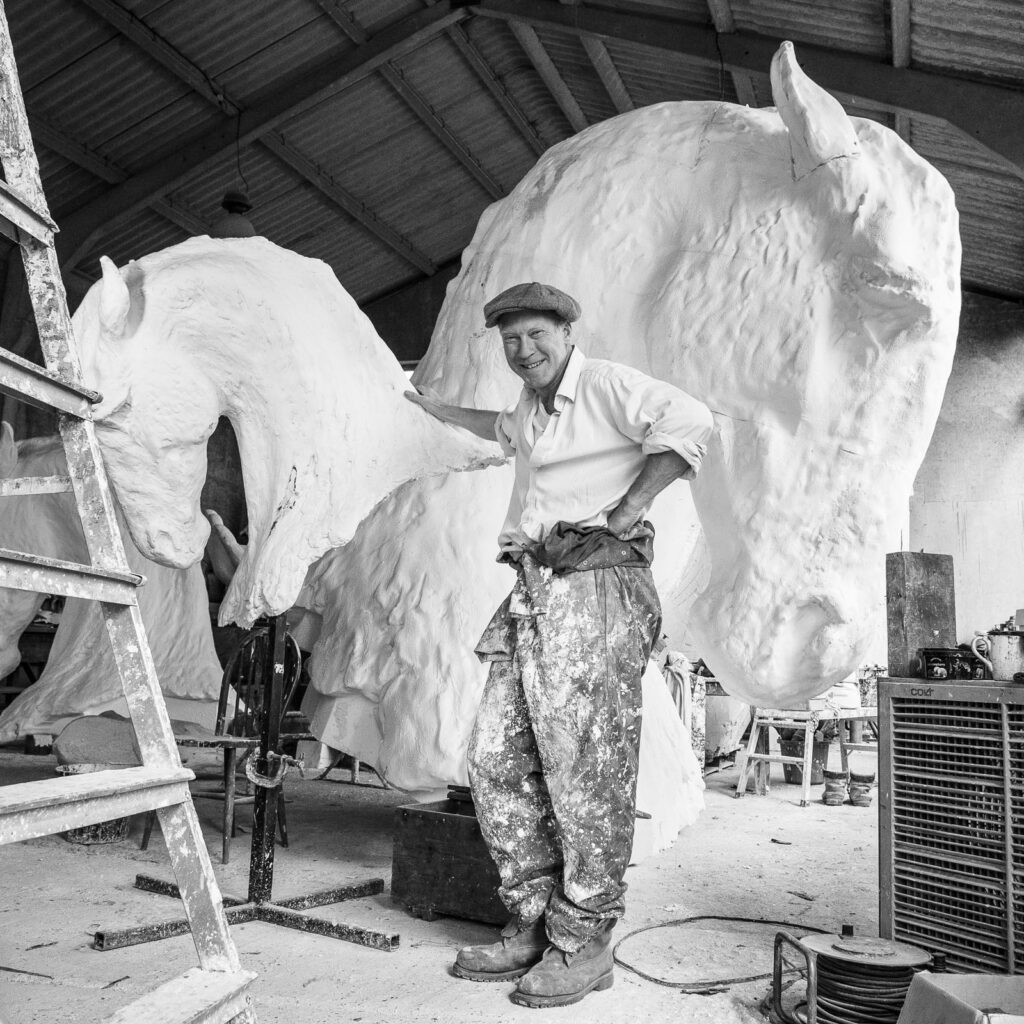
To read the rest of EQ Living’s January/February Issue click here.


